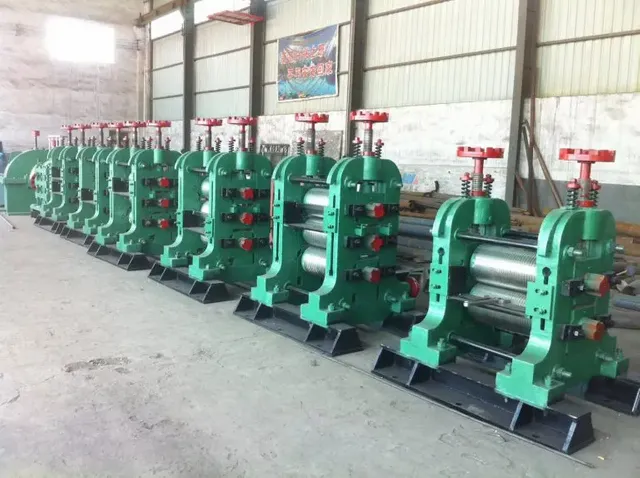Rolling mill machinery
Rolling mill equipment: the industrial backbone of metal shaping
In the history of metal processing, the emergence of rolling technology has completely changed the way humans shape materials. From the first generation of steam-driven rolling mills in the 18th century to today's intelligent continuous rolling production lines, rolling mill equipment is not only the heart of the metallurgical industry, but also the epitome of the transformation of modern manufacturing to precision and efficiency. This equipment, which applies pressure to metals by rotating rollers to change their cross-sectional shape and performance, supports the manufacturing needs from skyscraper steel structures to mobile phone chip lead frames. This article will systematically analyze the technological evolution, core structure and industrial value of rolling mill equipment.
Core components and technological breakthroughs of rolling mills
Modern rolling mills are complex integrations of mechanical, hydraulic and electronic control technologies. Their key modules include:
Roller system
The material of the working roll has evolved from high-chromium steel to high-speed steel (HSS) and tungsten carbide (WC). The Hyper UC series of rolls from Sumitomo Metal of Japan has a life of 12,000 tons/time, and the wear is reduced by 40%. The nano-coated roller developed by Baowu Group has a surface hardness of HRA92 and a thermal fatigue life that is three times longer.
Transmission device
The high-power AC/DC frequency conversion speed regulation system replaces the DC motor. Yaskawa Electric's MMC inverter achieves ±0.1% speed accuracy in the 5500mm wide and thick plate mill. The main motor power of Tangshan's hot rolling mill reaches 12,000kW, which is equivalent to the total power of 16 high-speed rail traction motors.
Thickness control system
The response time of the hydraulic AGC (automatic thickness control) system is less than 20ms. With the laser thickness gauge, the longitudinal thickness fluctuation of the cold-rolled thin plate is ≤0.5%. The Smart Gauge system of Posco in South Korea predicts the thermal expansion of the roller through big data, and the plate shape qualification rate is increased to 99.8%.
Intelligent platform
Digital twin technology realizes virtual commissioning. The digital model of the rolling mill built by Siemens for the Erdemir Steel Plant in Turkey shortens the equipment commissioning time by 30%. AI algorithms can predict the wear curve of the rollers and optimize the roller replacement cycle by 15%.
III. Industrial Application and Economic Benefits
Rolling mill equipment supports the trillion-level metal processing market:
Automobile manufacturing
2000MPa hot-formed steel rolling technology reduces the B-pillar of the car by 20% and improves the collision resistance by 30%. The 3mm thick 30X cold-rolled stainless steel used in the Tesla Cybertruck exoskeleton has a bending stiffness that is 5 times that of ordinary steel plates.
New energy field
The thickness of silicon steel rolling exceeds 0.15mm, and the steel loss of oriented silicon steel is reduced to 0.85W/kg, supporting the improvement of energy efficiency of ultra-high voltage transformers. The speed of CATL's pole mill reaches 120m/min, and the uniformity of copper foil thickness of 6μm reaches 98.5%.
Building revolution
The yield strength of TMCP steel plates (thermomechanical control process) for high-rise buildings reaches 690MPa, and the weight of the steel structure of Shanghai Tower is reduced by 25%. The weathering steel rolling technology developed by Laigang has extended the life of bridge steel without painting to 120 years.
Circular economy
The scrap steel recycling rolling line integrates laser sorting and electromagnetic purification. The scrap steel utilization rate of Baden Steel in Germany has reached 95%, and the energy consumption per ton of steel has been reduced by 65%.
IV. Technical challenges and innovation directions
The development of rolling mills faces three major bottlenecks:
Extreme manufacturing needs
Luders bands are prone to appear when rolling aluminum-lithium alloys for aviation skins. Voestalpine of France has developed asynchronous rolling technology, which increases the shear strain in the deformation zone by 50% and reduces anisotropy by 40%.
Green transformation
The rolling process accounts for 25% of the energy consumption of the steel industry. ThyssenKrupp has tested hydrogen fuel heating furnaces to reduce CO₂ emissions in the heating section to zero. Ansteel Group uses magnetic bearing technology to reduce the energy consumption of the main motor by 12%.
Intelligent operation and maintenance system
The rolling mill health management system deployed by Nucor Steel in the United States monitors the vibration spectrum in real time through 2,000 sensors, and the fault warning accuracy rate exceeds 90%.
Focus on future trends:
Ultra-large-scale: China Second Heavy Industries is developing a 5,500mm titanium alloy rolling mill that can integrally form a launch vehicle fuel tank.
Micro-scale: The rolling of electronic copper foil breaks through the thickness of 2μm to meet the needs of 5G base station heat sinks.
Digital twin: The full-process virtual rolling system developed by Danieli Group reduces the process optimization cycle from 3 months to 72 hours.
